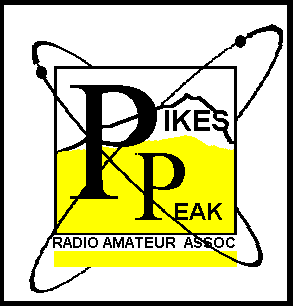— by Wes Wilson, KØHBZ
Emergency Coordinator/RACES Officer
Colorado ARES/RACES Disaster Response Team
On behalf
of the Colorado ARES/RACES Disaster Response Team (DRT), I would like to extend
a heartfelt “Thank You!’ to the PPRAA membership who voted (Oct. 12 meeting) a
very generous contribution to the ARES Deployment Fund to help offset expenses
incurred during our deployment to the Gulf coast to provide emergency communication
support in the wake of Hurricane Katrina.
Our
six-member unit was made up of Dean Haskins (KAØPII);
Mike Allen (NØMIK), Paul Garvey (KØBLM), Pat Kelly (KCØMIR), Tom Dawson (KCØNRZ) and myself.
All were anxious to go and willing to pay
our own expenses for the opportunity to field test our emergency communication
skills, training and equipment and help provide communication relief in areas
devastated by this powerful storm.
DRT home-based
support was provided by Sid White (K4ARM) and Mike Stansberry (KØTER) with
additional logistical and coordination support from our Colorado Section
Manager Jeff Ryan (KØRM) and Section Emergency Coordinator Rob Roller (N7LV).
We took four vehicles – Pat’s 33′ motorhome
(shelter/communications), my truck and 18′ camper trailer (shelter/communications)
and two pickup/SUV-type vehicles – one towing the solar-powered portable
repeater and the other towing a flatbed trailer with antennas, support masting,
coax, generators, gas, other equipment and supplies.
The trip took us over 3,000 miles and fuel alone was – by far – our
greatest expense, coming to a total of just under $3,200.
We were
requested by Gary Stratton, K5GLS, the ARRL Louisiana Section Emergency
Coordinator (SEC). We met up with Gary
in Covington, Louisiana, on our first night there and worked with him off and
on over the next six days.
Our trip took us to Covington,
Louisiana; across the Mississippi River to Gulfport and Ocean Springs,
Mississippi; back to Slidell and Pearl River, Louisiana; then across the
34-mile Causeway over Lake Pontchartrain into New Orleans.
We crossed back and forth across the
most-affected area of the Gulf coast where the eye-wall of Katrina made
landfall and caused the most devastation.
It was like being in a war zone.
As Mike Allen (NØMIK) said, “Life in these areas is like living in
a third-world country” – often no power, telephone, potable water, and
fuel was – at times – scarce or hard to find.
We were given new assignments every
24-36 hours and had to break our DRT Base Camp, move to a new location, and set
up again – something that was very challenging and frustrating in the
94-97-degree heat with 80-100% humidity.
This was an incredible test of our DRT training, equipment and
life-skill requirements in a major disaster venue.
The constant base camp moving was like having a week-long Field Day
in a disaster zone where you had to pack up and relocate your entire operation
at least 60 miles every 24-36 hours to a new unfamiliar site – and get set up
and operational very quickly.
We found our
flexibility in equipment, antennas and power options up to the task.
During our trip we provided
operator support to the Covington Chapter (St. Tammany Parish, LA) Red Cross
headquarters – that was communicating and coordinating with the Covington EOC,
their supply distribution center and numerous shelters and feeding operations in
surrounding areas.
In Mississippi, our team was split
– with Mike, Pat and Paul assigned to the Gulfport EOC where they worked shifts
monitoring the amateur frequencies and relaying emergency and priority messages
from the amateur frequencies to the various EOC agencies.
The other half of our team (Dean, Tom and I)
was sent to Ocean Springs, MS, where we provided a much-needed portable
repeater for their EOC and Red Cross shelter support operation.
In
addition we helped with communication at a shelter at St. Paul church and
provided some training by introducing several hams to the ICS-213 general
message form and discussed other issues.
The Gulfport and Ocean Springs operations were winding down, so after
about 36 hours, we found ourselves being redeployed back to Louisiana to
support Red Cross shelters in Slidell and Pearl River.
Upon arrival we found that cell phone
coverage was coming back online, so there wasn’t much amateur radio
requirement. We spent about 24 hours
there just to make sure.
FEMA was getting ready to allow New
Orleans residents back into the city for a couple of days to check their
properties and collect valuables (not to stay).
Red Cross was ramping up a major new feeding operation to provide
meals for these residents and it looked as if we might actually have a
large-scale NEW operation on our hands.
Red Cross asked us to assemble a team of at least 10 operators and to
stage at an abandoned Wal-Mart store in New Orleans.
We picked up two operators from Washington state, one from Texas
and another from Louisiana that we had been working with at Covington and
deployed our expanded team across the 34-mile causeway over Lake Pontchartrain into
New Orleans.
Security was a major concern in New
Orleans, so we had to set up a “defensible” DRT base camp by using a 10′
security fence with vegetation behind us, then forming our RVs (three at that
point) in a “U” shape with room to put our equipment trailers/portable repeater
in the center (to discourage theft of generators and spare gas) and close off
the “U” with our tow vehicles at night.
Sometime during the day, Red Cross
changed their plans and relocated the food supply operation to Baton Rouge – but
neglected to notify us – so what had promised to be a valuable support mission
turned out to be a 24-hour wild goose chase instead.
On our trip down to the Gulf, we
were being passed on the highway by cellular “COWS” (Cellular On
Wheels). These are complete portable
generator-powered cellular systems that are loaded on flatbed trucks,
transported, dropped and set up wherever needed.
There is a fierce battle between cellular providers to be the
FIRST cellular system back up after a disaster – the winner of that battle has
bragging rights that greatly increase their corporate market share and
profits. In this event, cellular
started coming solidly back on line about the time we arrived – roughly two
weeks after landfall. With the fierce
competition, this cellular recovery time will certainly decrease as cell
providers improve their disaster response capabilities.
One of the biggest lessons learned
is that the role and scope of amateur radio emergency communications is
changing dramatically as a result of improvements in the cellular industry.
Amateur radio must focus on providing
communications from the immediate outset until cellular takes over – that was
roughly 14 days in this event, and – with advances in cellular disaster preparedness – that number is
bound to come down.
I expect, within the next few
years, to see “Flying COWs” – portable cellular sites brought in by cargo
aircraft and positioned atop buildings and other tall areas by heavy
helicopters. This will further reduce
the timeframe for amateur operations – perhaps to as little as a few days, or a
week.
Amateur radio response was way
behind the power curve in Katrina, Rita – and now Hurricane Wilma.
When Katrina was approaching the Gulf coast,
I sent an inquiry to the DRT membership asking who would be interested and willing
to go. We had six members sign up.
That information was given to our ARRL
Colorado Section Manager Jeff Ryan (KØRM) who relayed our offer to the
League. I recommended pre-staging our
DRT resources in Little Rock, Arkansas so we would be ready to deploy into the
affected area immediately after landfall.
Instead – following the ARRL directives – we waited on the process for
nearly two weeks before we received ANY deployment request. This is entirely TOO LATE!
Hurricanes are unique as disasters
go – because we can see them coming for many days in advance. All disaster response agencies (except
amateur radio) use that time to activate and mobilize their resources, identify
areas of potential need and pre-stage their resources.
It is IMPERATIVE that Amateur radio do the
EXACT same thing – the League must develop and administer a program to identify,
evaluate, certify and credential amateur radio emergency responders (both
individuals and teams) and categorize them based on their training, experience,
equipment and capability. We must then
have a system to contact these ham responders (or have them contact the League)
so they can be pre-staged and ready to deploy immediately when disaster
strikes. We can’t wait until after a
disaster to start this process. Amateur
radio emergency response must be proactive not reactive.
This is CRITICAL to the future of amateur
radio and needs to be a top priority of the ARRL.
Another lesson learned was the
value of GPS guided computer navigation.
Often we were given only a location name and/or street address where we
needed to report. We had to calculate
our route and figure out how to get there.
What we forget is – in a major disaster – the highway, informational and
street signs are no longer there – in fact – often the posts, signal lights or
power poles that once held the signs are no longer there (well, not upright,
anyway!). Our navigator, Tom Dawson (KCØNRZ)
led us directly where we needed to go – time after time – coordinating our
caravan navigation on 446.150 simplex.
In addition, while I had been using
Pactor I for Winlink E-mail via HF radio to send/receive E-mail in the field,
we were able to get our new SCS PTCII-Pro TNCs operational and use the infinitely
faster Pactor III language. This served
us well for coordinating back to Red Cross HQ, some messaging, and keeping
Colorado Section officials and our families updated on our situation and
status. Digital is the future of
amateur radio emergency communications and the DRT has its own Digital Development
Group exploring these emerging technologies, documenting and sharing the
results with our members and other ARES/RACES groups.
In addition, with Tom’s help, we
further developed our computer wireless network so agency personnel with wireless-capable
computers can use their normal E-Mail client (like Outlook Express) to create
messages on their own computers and upload them to the “Transit” folder in my
Airmail software on my HF digital station.
Those E-mail messages then are automatically transferred and delivered
the next time I connect to a HF Winlink PMBO station.
This means that several agency personnel can simultaneously generate
their own E-mail messages (and even include attachments!) and upload them via
conventional computer wireless to our HF digital station for transmission.
The many lessons learned by the DRT
are far to numerous to detail here, however, these lessons will be documented
and incorporated back into Colorado ARES/RACES training and be used to help our
local emergency communication groups be better equipped and prepared for future
emergency operations here in Colorado – or wherever we might be needed.
Again, my sincerest thanks to the
PPRAA membership for your help and generous support of this very important
learning experience. 73
=
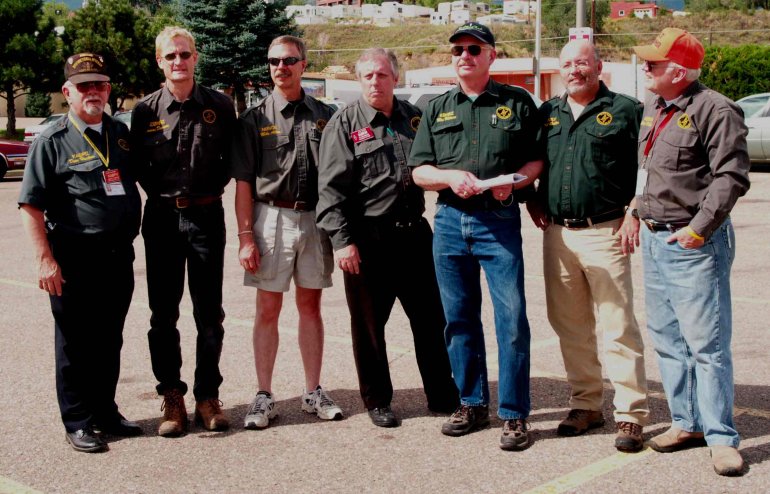
Jeff Ryan and Rob Roller (N7LV) stopped by to see the team
off. From left: Dean, Tom, Mike, Jeff, Wes, Rob and
Pat. Not pictured, Paul Garvey (KØBLM)
who deployed a day later.
=
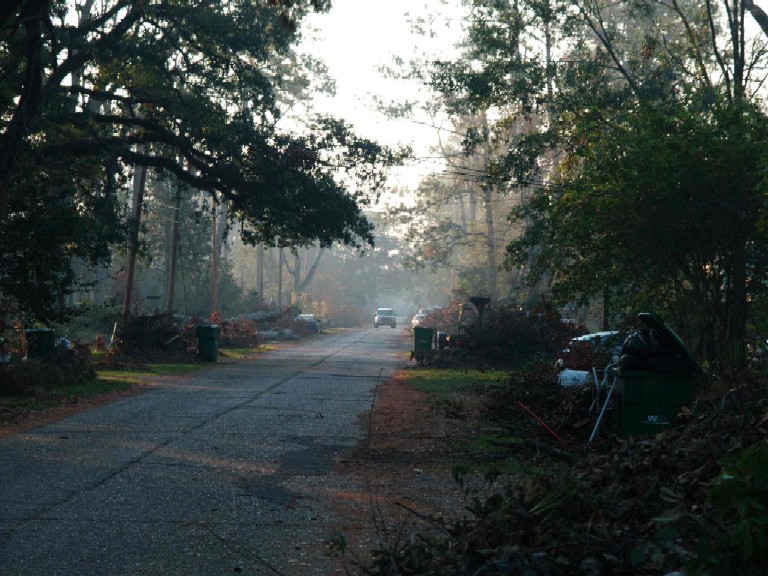
We were shocked upon arrival in Covington, LA – the city
looked like a war zone. It made it
difficult to navigate (especially with our larger RV vehicles).
=
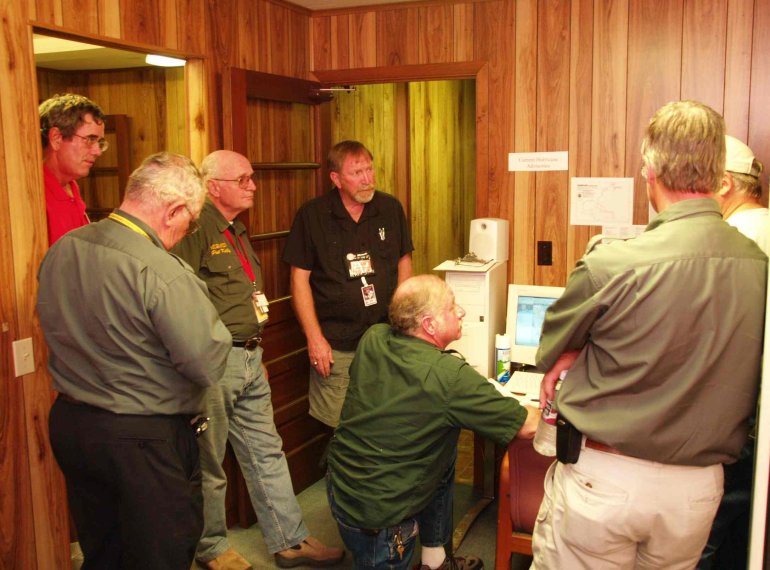
DRT members joined local hams for
a mission briefing in the communications room of the Covington (LA) Red Cross
HQ. The ham in the black shirt (center)
is Gary Stratton (K5GLS), ARRL Louisiana Section Emergency Coordinator.
=
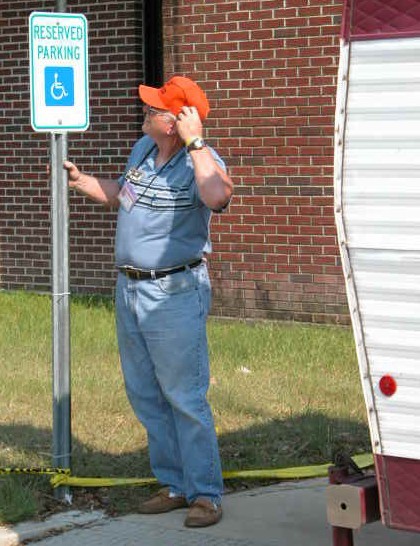
What good is a handicapped parking
sign in a disaster?
=
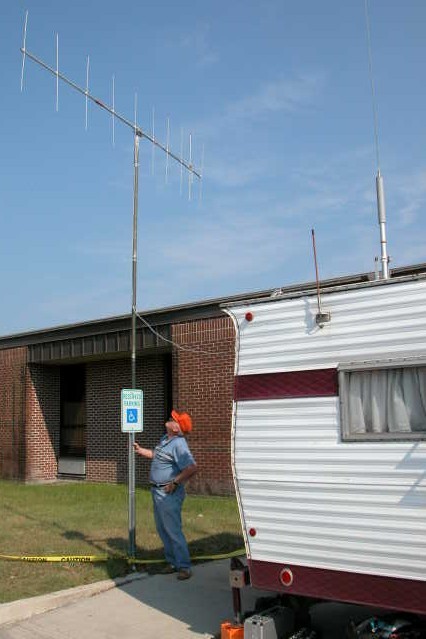
If it survived a category 4 hurricane, it can probably
support an 11-element VHF beam! The 20-foot
mast was lashed to the sign post using heavy duty zip ties.
Slidell Shelter, LA.
=
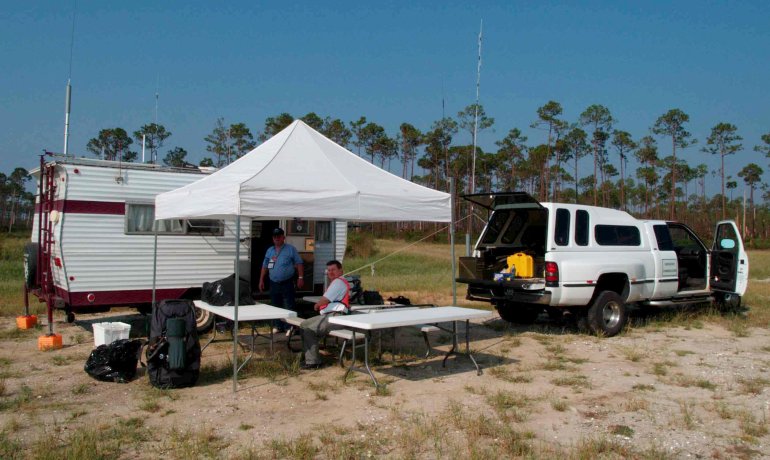
DRT base camp at Ocean Springs, MS.
Antennas include V/UHF dual-band and HF
screwdriver antennas on top of camper, Cushcraft R-7 (10m-40m) vertical in
background. Screwdriver was used for
75m nets and the Cushcraft was used for both HF SSB and digital – Winlink
E-mail communication.
=
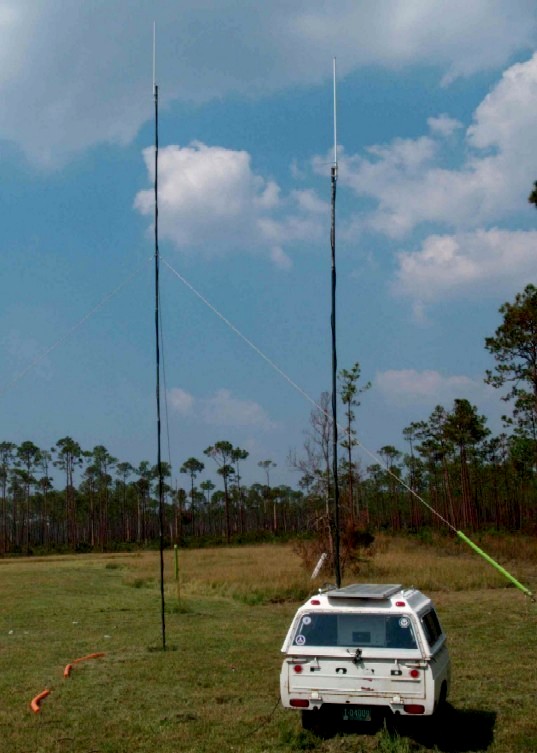
KØHBZ’s solar-powered portable repeater (“The Roach”) was
deployed to support EOC and shelter operations in Ocean Springs, MS.
A 46-foot guyed mast was put up to extend
range slightly over the 31-foot freestanding mast on the unit.
The unit contains a VHF repeater (two
frequency pairs) with a UHF link radio, a UHF repeater (two frequency pairs)
and a V/UHF packet node/PBBS. Ocean
Springs repeaters were all down and hams were delighted to have the repeater as
they had been having a frustrating time relaying messages back and forth on
simplex. With the repeater, all net stations
had direct contact with one another.
=
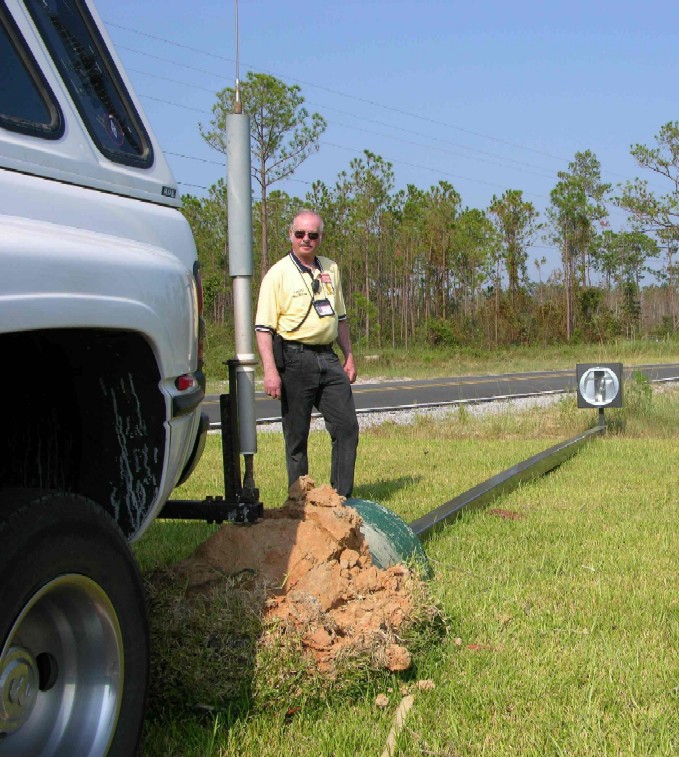
Actually, Wes didn’t really back into this lamp post in
Ocean Springs, MS – Hurricane Katrina did the damage, Wes just happened to park
there.
=
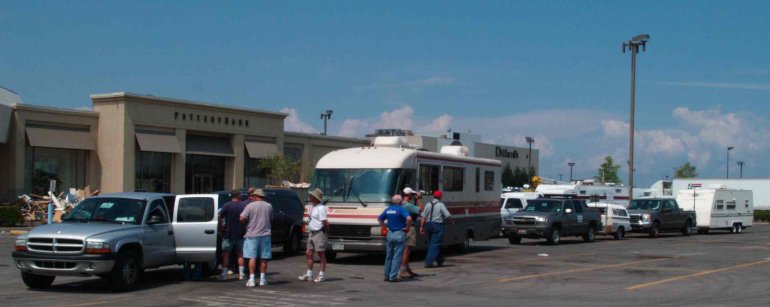
Having picked up four additional operators for a special
mission into New Orleans, the DRT convoy (now made up of 10 operators in seven
vehicles) pulled over after crossing the 34-mile causeway across Lake Pontchartrain
and met a local ham for directions to our final destination.
